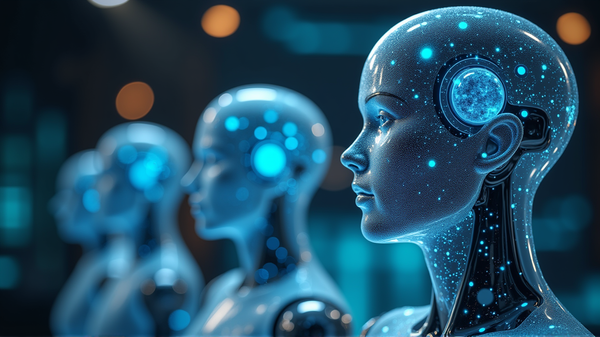Google Signs the World’s First Agreement for Access to Nuclear Power to Fuel AI Projects
Google has made history by signing the world’s first-ever agreement to power its artificial intelligence (AI) projects using electricity generated from small modular nuclear reactors (SMRs). This groundbreaking deal, which has the potential to reshape the future of energy consumption in the tech industry, was reported by The Guardian.
Under the agreement with the startup Kairos Power, Google will support the construction of six or seven small modular reactors that will generate a total of 500 megawatts of electricity. The first reactor is projected to be online by 2030, with the remaining reactors expected to be operational by 2035.
The primary goal of this partnership is to provide Google with a low-carbon energy solution to power its data centers, which consume enormous amounts of electricity to support the ever-growing demands of AI and data processing. According to The Guardian, the rapid expansion of generative AI technologies, as well as the rise of cloud storage, has significantly increased the energy needs of tech giants like Google, Microsoft, and Amazon.
A New Era of Energy Solutions for AI
As AI continues to evolve, so do its energy requirements. Generative AI, a field that includes technologies like large language models and image generators, demands significant computational power. This growth, combined with the expansion of cloud-based services, has put increasing pressure on tech companies to seek sustainable energy sources to meet their needs.
Google’s collaboration with Kairos Power reflects a forward-thinking approach to solving this issue. By turning to nuclear energy, specifically through the use of small modular reactors, Google is addressing both the energy demand and the environmental impact of AI. Unlike traditional nuclear reactors, SMRs are smaller, more flexible, and considered safer due to their modern designs. They can be built in less time and at a lower cost compared to conventional large-scale nuclear power plants.
With the growing push for companies to reduce their carbon footprints, the adoption of nuclear power is seen as a viable long-term solution. Nuclear energy, which produces no direct carbon emissions, can play a critical role in achieving net-zero emissions while providing the vast amounts of power needed by data centers and AI technologies.
The Nuclear Power Race Among Tech Giants
Google is not the only tech giant turning to nuclear power to fuel its AI ambitions. Last month, Microsoft made headlines when it brought a decommissioned nuclear reactor back online at the Three Mile Island site to power its AI servers. This marked the first time in U.S. history that a closed nuclear plant was revived for energy production, especially to supply electricity for a single customer.
Amazon has also jumped into the nuclear energy arena. Earlier this year, the e-commerce giant purchased a data center powered by nuclear energy from Talen Energy. This move demonstrates the increasing interest in using nuclear power to meet the escalating energy needs of the tech industry.
As AI development continues to accelerate, the cost of using these technologies is expected to rise. For instance, OpenAI, the company behind the popular AI chatbot ChatGPT, plans to increase the monthly subscription fee for its service from $20 to $44 by 2029. The reason? Higher energy and operational costs due to the growing complexity and power demands of AI models.
The Future of AI and Nuclear Power
The adoption of nuclear power by tech companies is not just a matter of meeting current energy demands—it’s about planning for the future. By 2024, OpenAI is set to launch ChatGPT-5, a new iteration of its AI model that promises to revolutionize the field of artificial intelligence. This new version of ChatGPT is expected to move AI closer to achieving Artificial General Intelligence (AGI)—an AI capable of performing any intellectual task that a human can.
AGI represents a monumental shift in AI’s capabilities. Rather than being specialized for particular tasks, AGI would be able to learn and execute any task a human could conceive of, making it nearly indistinguishable from human intelligence. This leap forward in AI development will undoubtedly require even more computational power, further increasing the demand for reliable, sustainable energy sources.
In response to these growing needs, nuclear power is quickly becoming an attractive option for companies looking to ensure both energy security and environmental sustainability. Small modular reactors, in particular, offer a promising solution due to their scalability, safety, and low-carbon emissions. With the backing of tech giants like Google, Microsoft, and Amazon, the future of AI may very well be powered by the atom.
Why Modular Reactors?
Small modular reactors (SMRs) are designed to be more flexible and affordable compared to traditional nuclear reactors. They have a smaller physical footprint and can be built in a fraction of the time, making them ideal for projects that need to scale quickly, such as those in the tech industry.
Moreover, SMRs are seen as a safer alternative due to their advanced safety features. These reactors are designed to automatically shut down in case of an emergency, reducing the risk of accidents. Additionally, their smaller size makes it easier to manage potential issues and ensure safe operation.
For Google, the decision to invest in nuclear power through Kairos Power is a strategic move that aligns with its broader sustainability goals. The company has long been committed to reducing its carbon footprint, and this latest partnership highlights its dedication to exploring innovative energy solutions to support its AI ambitions.
The Rising Costs of AI
As AI technologies continue to evolve, so do their operational costs. The sheer amount of data required to train and run AI models like ChatGPT has led to a significant increase in energy consumption. This, in turn, has driven up the cost of using these technologies.
OpenAI, for example, has already announced plans to raise the subscription fee for ChatGPT from $20 per month to $44 by 2029. This increase reflects the rising costs associated with maintaining and expanding AI infrastructure, including energy, server maintenance, and ongoing research and development.
These rising costs underscore the importance of finding sustainable energy solutions. For companies like Google, turning to nuclear power is not just about meeting current energy needs—it’s about future-proofing their operations in an increasingly competitive and resource-intensive industry.
A New Frontier in AI and Energy
The partnership between Google and Kairos Power represents a new frontier in the relationship between AI and energy. As AI technologies continue to push the boundaries of what’s possible, the demand for sustainable, reliable energy sources will only grow.
By investing in small modular reactors, Google is not only securing a low-carbon energy source for its data centers but also positioning itself as a leader in the movement towards sustainable AI. This move could set a precedent for other companies in the tech industry, pushing them to explore similar solutions as they face the challenge of meeting the growing energy demands of AI.
With the first reactor expected to be operational by 2030, and the rest by 2035, the future of AI may be powered by nuclear energy sooner than we think. As tech companies continue to innovate, the convergence of AI and nuclear power could pave the way for a more sustainable and efficient future—one where the incredible potential of AI is fueled by clean, reliable energy sources.
Conclusion
Google’s partnership with Kairos Power to build small modular reactors marks a significant step forward in the quest for sustainable energy solutions for AI. As the tech industry grapples with the rising energy demands of AI and data processing, nuclear power is emerging as a viable, low-carbon alternative.
This deal highlights the growing importance of energy security and sustainability in the tech world. With other giants like Microsoft and Amazon also investing in nuclear power, the race to develop clean energy solutions for AI is heating up.
As AI technologies continue to evolve, the need for innovative energy solutions will only become more pressing. Google’s decision to invest in small modular reactors is a forward-thinking move that could reshape the future of both AI and energy, setting a new standard for how tech companies power their operations in the 21st century.




